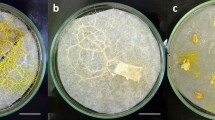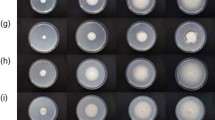Abstract
This paper deals mainly with the conidium ontogenesis and phylogenesis of black yeasts such as E. jeanselmei, E. gougerotii, E. dermatitidis and E. spinifera.
The conidium ontogenesis of E.jeanselmei, E. gougerotii and E. dermatitidis was almost the same. One to five annellated tips were observed through a scanning microscope at the apices of conidiogenous cells, which were bottle- or jar-shaped. Annellations on the tips looked like fringes and the conidiogenous cells of these three species were annellides. Annellated projections occurred on hyphae and annelloconidia were also produced from them. Occasionally, secondary annellides occurred from primary ones. They looked like moniliform hyphae. Daughter conidia sometimes budded directly from mother cells. The shapes and sizes of the conidia of these species were very similar to each other.
The conidium ontogenesis of E. spinifera was annellidic as well. However, a single annellated tip usually occurred on an annellide. The annellated tips of the fungus were long and more than 20 annellations were observed on their walls. The conidiogenesis of the four species of Exophiala is only annellidic.
There were no differences in the biological examinations except KNO3 assimilation among these four species. The growth of E. jeanselmei and E. gougerotii was poor at 37 °C.
The GC contents of E. jeanselmei 1171, E. gougerotii B-1800, E. dermatitidis MM-7 and E. spinifera DU-3342 were 54.6, 54.6, 56.6 and 59.7%, respectively.
Similar content being viewed by others
References
Borelli, D., 1955. Sporotrichum gougerotii, Hormiscium dermatitidis, Phialophora jeanselmei: Phialophora gougerotii (Matruchot, 1910) comb.n. Memorias VI Congreso Venezolano de Ciencias Medias 5: 2945–2971.
Butterfield, W. & Jong, S. C., 1976. Effect of carbon source on conidiogenesis in Fonsecaea dermatitidis, an agent of chromomycosis. Mycopathologia 58: 59–62.
Carmichael, J. W., 1966. Cerebral mycetoma of trout due to a Phialophora-like fungus. Sabouraudia 5: 120–123.
Carrión, A. L., 1950. Yeast-like dematiaceous fungi infecting the human skin. Arch. Dermatol. 61: 996–1009.
Carrión, A. L. & Silva, M., 1955. Sporotrichosis special reference: A recision of so-called Sporotrichum gougerotii. Arch. Dermatol. Syph. 72: 523–534.
Cole, G. T., 1978. Conidiogenesis in the black yeast. In The Black and White Yeasts, Pan American Health Organization, Washington, D.C. p. 66–78.
Conant, N. F., Smith, D. T., Baker, R. D., Callaway, J. L. & Martin, D. S.: Manual of Clinical Mycology, 2nd ed. p. 262–263 Philadelphia, W. B. Saunders, 1954. Ditto, 3rd ed. p. 514–516, 1971.
Cooke, W. B., 1962. A taxonomic study in the ‘black yeasts’. Mycopathol. Mycol. appl. 17: 1–43.
De Hoog, G. S., 1977. Rhinocladiella and allied genera. In Studies in mycology, No 15 The Black Yeasts and Allied Hyphomycetes p. 1–132.
Emmons, C. W., 1966. Pathogenic dematiaceous fungi. Jpn. J. Med. Mycol. 7: 233–245.
Emmons, W. C., Binford, C. H., Utz, J. P. & Kwon-Chung, K.J.: Medical Mycology 3rd ed. p. 386–405, p. 425–463, Lea & Febiger, Philadelphia, 1977.
Gustafson, R. A., Hardcastle, R. V. & Szaniszlo, P. J., 1975. Budding in the dimorphic fungus Cladosporium werneckii. Mycologia 67: 842–951.
Iwatsu, T. & Miyaji, M., 1978. Subcutaneous cystic granuloma caused by Phialophora verrucosa. Mycopathologia 64: 165–168.
Iwatsu, T., Miyaji, M. & Okamoto, S., 1981. Isolation of Exophiala jeanselmei from nature in Japan. Jpn. J. Med. Mycol. 22: 234–242.
Jotisankasa, V., Nielsen Jr., H. S. & Conant, N. F., 1970. Phialophora dermatitidis; Its morphology and biology. Sabouraudia 8: 98–107.
Kano, K., 1938. Über die Chromoblastomykose durch einen noch nicht als pathogen beschriebenen Pilz: Hormiscium dermatitidis n. sp. Arch. Dermatol. Syph. 176: 282–294.
McGinnis, M. R., 1977. Exophiala spinifera, a new combination for Phialophora spinifera. Mycotaxon 5: 337–340.
McGinnis, M. R. & Padhye, A. A., 1977. Exophiala jeanselmei, a new combination for Phialophora jeanselmei. Mycotaxon 5: 341–352.
McGinnis, M. R., 1977. Wangiella, a new genus to accommodate Hormiscium dermatitidis. Mycotaxon 5: 353–363.
McGinnis, M. R., 1977. Wangiella dermatitidis, a correction. Mycotaxon 6: 367–369.
McGinnis, M. R., 1978. Human pathogenic species of Exophiala, Phialophora, and Wangiella. In The Black and White Yeasts, Pan American Health Organization, Washington, D.C. p. 37–59.
Nakase, T. & Komagata, K., 1968. Taxonomic significance of base composition of yeast DNA. J. Gen. Appl. Microbiol. 14: 345–357.
Nakase, T. & Komagata, K., 1971. DNA base composition of some species of yeasts and yeast-like fungi. J. Gen. Appl. Microbiol. 17: 363–369.
Nielsen, Jr. H. S. & Conant, N. F., 1968. A new human pathogenic Phialophora. Sabouraudia 6: 228–231.
Nishimura, K. & Miyaji, M., 1982. Studies on a saprophyte of Exophiala dermatitidis isolated from a humidifier. Mycopathologia 77: 173–181.
Oujezdsky, K. B., Grove, S. N. & Szaniszlo, P. J., 1973. Morphological and structural changes during the yeast-to-mold conversion of Phialophora dermatitidis. J. Bacteriol. 113: 468–477.
Oujezdsky, K. B. & Szaniszlo, P. J., 1974. Conidial ontogeny in Phialophora dermatitidis. Mycologia 66: 537–542.
Padhye, A. A., 1978. Comparative study of Phialophora jeanselmei and P. gougerotii by morphological, biochemical, and immunological methods. In The Black and White Yeasts, Pan American Health Organization, Washington, D.C. p. 60–65.
Schol-Schwarz, M. B., 1968. Rhinocladiella, its synonym Fonsecaea and its relation to Phialophora. Antonie van Leeuwenhoek 34: 119–152.
Storck, R. & Alexopoulos, C. J., 1970. Deoxyribonucleic acid of fungi. Bacteriol. Rev. 34: 126–154.
Suzuki, S. & Takeda, N., 1977. Immuno-chemical studies on the galactomannans isolated from mycelia and culture broths of three Hormodendrum strains. Infect. Immun. 17: 483–490.
Von Arx, J. A., 1981. Systematics of conidial yeasts. In Biology of Conidial Fungi (Cole, G. T. & Kendrick, B., eds.), Vol. 1, p. 85–96. Academic Press, New York.
Wang, C. J. K., 1966. Annellophores in Torula jeanselmei. Mycologia 58: 614–621.
Author information
Authors and Affiliations
Rights and permissions
About this article
Cite this article
Nishimura, K., Miyaji, M. Studies on the phylogenesis of pathogenic ‘black yeasts’. Mycopathologia 81, 135–144 (1983). https://doi.org/10.1007/BF00436818
Issue Date:
DOI: https://doi.org/10.1007/BF00436818




